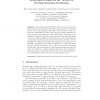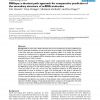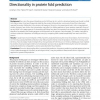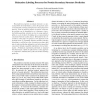60 search results - page 2 / 12 » A Comparative Study of Parallel Metaheuristics for Protein S... |
EVOW
2012
Springer
12 years 29 days ago
2012
Springer
Abstract. The hydrophobic-polar (HP) model for protein structure preabstracts the fact that hydrophobic interactions are a dominant force in the protein folding process. This model...
BMCBI
2008
13 years 5 months ago
2008
Background: Residue depth allows determining how deeply a given residue is buried, in contrast to the solvent accessibility that differentiates between buried and solvent-exposed ...
BMCBI
2007
13 years 5 months ago
2007
Background: In recent years, RNA molecules that are not translated into proteins (ncRNAs) have drawn a great deal of attention, as they were shown to be involved in many cellular ...
BMCBI
2010
13 years 9 days ago
2010
Background: Ever since the ground-breaking work of Anfinsen et al. in which a denatured protein was found to refold to its native state, it has been frequently stated by the prote...
ICPR
2004
IEEE
14 years 6 months ago
2004
IEEE
The prediction of protein secondary structure is a classical problem in bioinformatics, and in the past few years several machine learning techniques have been proposed to t. From...




